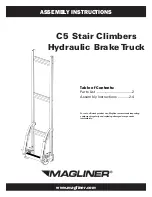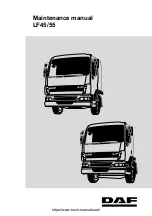
Filling The Def Tank In Cold Climates
Since DEF will begin to freeze at 12°F (-11°C), your
vehicle is equipped with an automatic DEF heating sys-
tem. This allows the DEF injection system to operate
properly at temperatures below 12°F (-11°C). If your
vehicle is not in operation for an extended period of
time with temperatures below 12°F (-11°C), the DEF in
the tank may freeze. If the tank is overfilled and
freezes, it could be damaged. Therefore, do not overfill
the DEF tank.
Extra care should be taken when filling with portable
containers to avoid overfilling. Note the level of the DEF
gauge in your instrument cluster. You may safely add a
maximum of 2 gal (7.5 L) of DEF from portable contain-
ers when your DEF gauge is reading ½ full.
VEHICLE LOADING
GROSS VEHICLE WEIGHT RATING
(GVWR)
The GVWR is the total permissible weight of your vehicle
including driver, passengers, vehicle, options and cargo.
The label also specifies maximum capacities of front
and rear axle systems (GAWR). Total load must be lim-
ited so GVWR and front and rear GAWR are not
exceeded.
PAYLOAD
The payload of a vehicle is defined as the allowable
load weight a truck can carry, including the weight of
the driver, all passengers, options and cargo.
GROSS AXLE WEIGHT RATING
(GAWR)
The GAWR is the maximum permissible load on the
front and rear axles. The load must be distributed in the
cargo area so that the GAWR of each axle is not
exceeded.
Each axle GAWR is determined by the components in
the system with the lowest load carrying capacity (axle,
springs, tires or wheels). Heavier axles or suspension
components sometimes specified by purchasers for
increased durability does not necessarily increase the
vehicle's GVWR.
TIRE SIZE
The tire size on the Vehicle Certification Label repre-
sents the actual tire size on your vehicle. Replacement
tires must be equal to the load capacity of this tire size.
RIM SIZE
This is the rim size that is appropriate for the tire size
listed.
INFLATION PRESSURE
This is the cold tire inflation pressure for your vehicle
for all loading conditions up to full GAWR.
CURB WEIGHT
The curb weight of a vehicle is defined as the total
weight of the vehicle with all fluids, including vehicle
fuel, at full capacity conditions, and with no occupants
or cargo loaded into the vehicle. The front and rear curb
weight values are determined by weighing your vehicle
on a commercial scale before any occupants or cargo
are added.
LOADING
The actual total weight and the weight of the front and
rear of your vehicle at the ground can best be deter-
mined by weighing it when it is loaded and ready for
operation.
The entire vehicle should first be weighed on a commer-
cial scale to ensure that the GVWR has not been
exceeded. The weight on the front and rear of the
vehicle should then be determined separately to be
sure that the load is properly distributed over the front
and rear axles. Weighing the vehicle may show that the
GAWR of either the front or rear axle has been
exceeded but the total load is within the specified
GVWR. If so, weight must be shifted from front to rear or
rear to front as appropriate until the specified weight
limitations are met. Store the heavier items down low
and be sure that the weight is distributed equally. Stow
all loose items securely before driving.
Improper weight distributions can have an adverse
effect on the way your vehicle steers and handles and
the way the brakes operate.
WARNING!
Do not load your vehicle any heavier than the GVWR,
maximum Payload or maximum front and rear GAWR.
If you do, parts on your vehicle can break, or it can
change the way your vehicle handles. This could
cause you to lose control. Overloading can shorten
the life of your vehicle.
STARTING AND OPERATING
151
4
Summary of Contents for CHASSIS CAB 2024
Page 69: ...GETTING TO KNOW YOUR INSTRUMENT PANEL MIDLINE INSTRUMENT CLUSTER GASOLINE 67 3...
Page 71: ...HIGHLINE INSTRUMENT CLUSTER GASOLINE GETTING TO KNOW YOUR INSTRUMENT PANEL 69 3...
Page 75: ...MIDLINE INSTRUMENT CLUSTER DIESEL GETTING TO KNOW YOUR INSTRUMENT PANEL 73 3...
Page 77: ...HIGHLINE INSTRUMENT CLUSTER DIESEL GETTING TO KNOW YOUR INSTRUMENT PANEL 75 3...
Page 357: ......
Page 358: ......







































